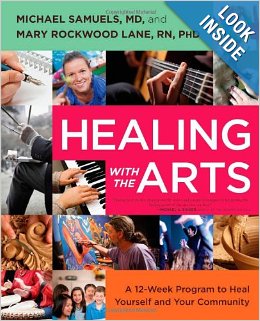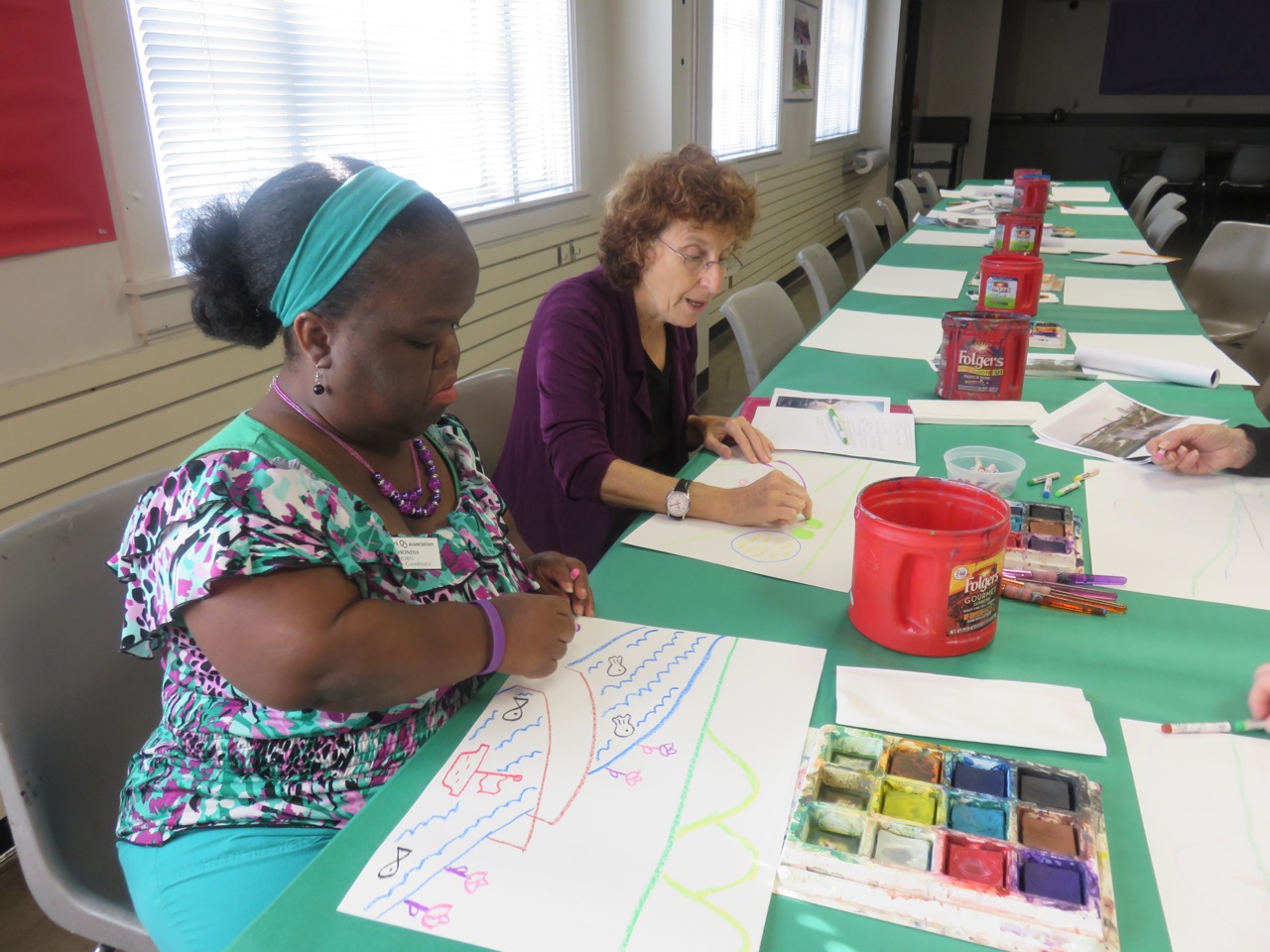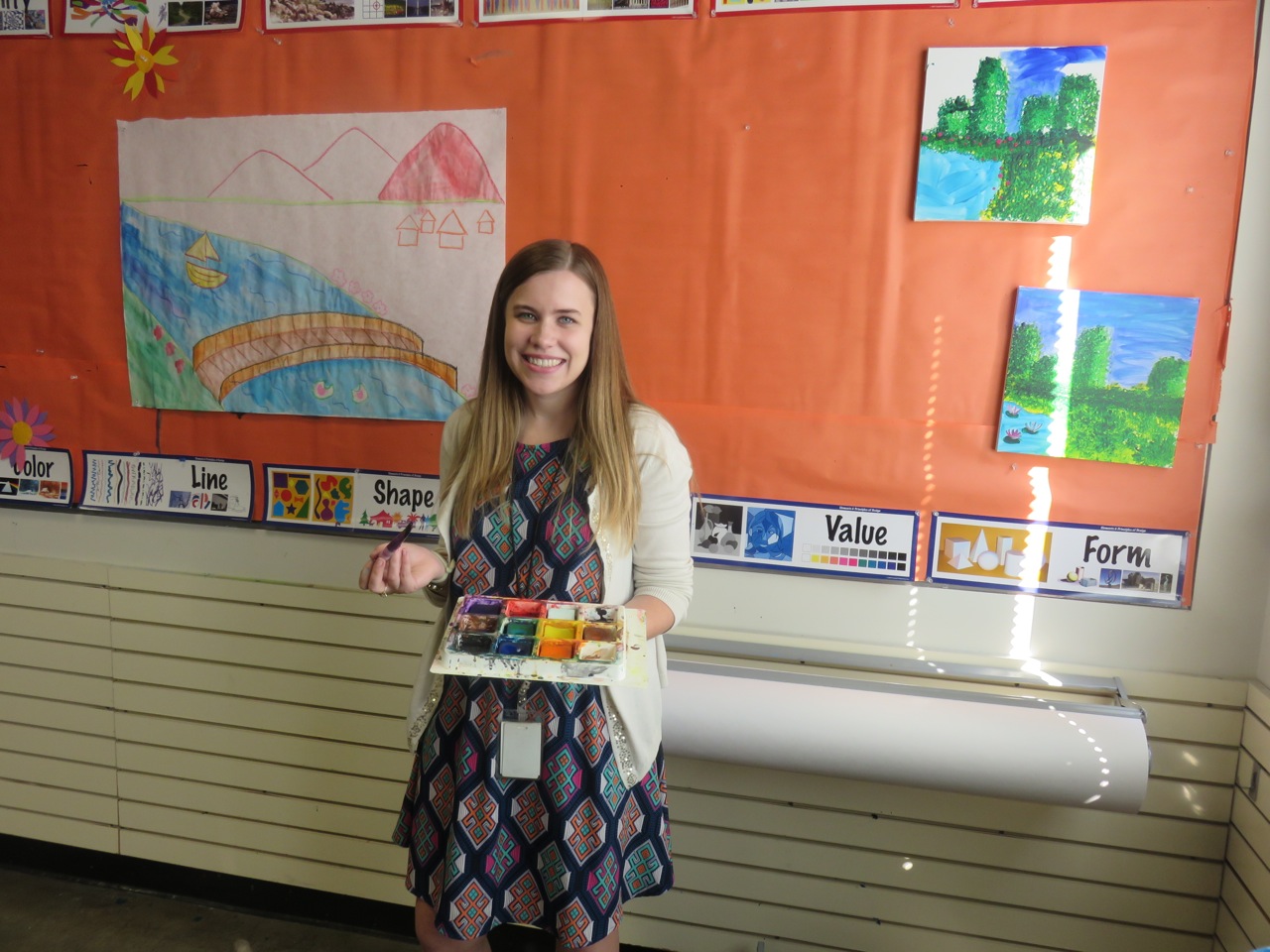Posts Tagged ‘Art’
To Bee or Not to Bee
Have you ever wondered if you’re living your highest purpose, if you’re on the right path? Have you ever received a sign from “the universe” that you took as an affirmation of your direction?
I often ask myself that question and watch for a sign. Of course, the ideal sign is a shaft of ethereal light beaming through the clouds and a heavenly voice that assures, “Yes, you are on your path.” But that’s never happened for me. My most recent sign came from a buzzing insect. Click here if you’d like to hear the story or keep reading if you prefer the written word.
Warmly, Deborah
Deborah Shouse is the author of Love in the Land of Dementia: Finding Hope in the Caregiver’s Journey.
Normally, I am afraid of bees.
But recently, I was sitting outdoors at a neighborhood restaurant, telling my friend Sarah about my new writing book called Creativity in the Land of Dementia: Finding Inspiration in the Care Partner’s Journey. As I talked about collecting expressive therapies to stimulate and engage people living with dementia and their care partners, the first bee cruised by my faro and fruit salad. The bee landed on the edge of my plate and reached out a tentative antenna to fondle a thin slice of apple.
I did not instantly jump away: instead I felt a sense of calm and connection around the bee. “Thank you for the good work you’re doing, “ I told the bee, hoping it would take the hint and move on. I continued telling Sarah about the renewal tips I wanted to write for weary care partners when a second bee buzzed by and danced around on an apple slice.
I put the two bee-spotted apples on a separate small plate and placed it on the far end of the table.
“This is for you,” I told the bees.
They enjoyed the apples for a while, then returned with friends to explore my salad further. I put all the slices of apples on the small plate and waved them toward that corner of the table.
But despite the fact that my plate now held nothing but faro, a plain tasting ancient grain, the bees returned to buzz around me.
Sarah and I changed tables, leaving our food behind. The bees followed.
Again, we moved to another table. And again, the bees followed, buzzing around me.
Finally, we agreed it was time to leave.
The next morning I received an email from Sarah. She was so curious about my sudden popularity with the pollinators that she looked them up in her animal medicine cards. She discovered that bees indicated:
It’s time to get organized and get to work on that idea that you want to implement and develop.
Approach your projects with commitment, diligence, and dedication, and you’ll succeed beyond your wildest expectations.
Involve several others in a cooperative and life-affirming venture, one in which everyone who participates will benefit-and if possible, one that involves the entire community.
Those sentences captured the essence of my project, a book that will benefit the community and that I want to organize, commit to, and involve others in.
I got a “buzz” just reading the description. I was also grateful for such a lovely affirmation; a sign that I was on my right path. And during a time when I was extremely busy, the experience also offered me an important spiritual reminder: “Just bee.”
Want to be part of Creativity in the Land of Dementia: Finding Inspiration in the Care Partner’s Journey? I’m looking for stories about people with dementia who are giving back to their community or living with dementia in an unusual and creative way. I am seeking renewal tips from care partners. And I am interested in fascinating creative activities that both inspire and engage.
Focusing on Art and Drawing on Memory
“What art offers is space – a certain breathing room for the spirit.” ~John Updike
“I want us to explore this work of art together,” Laura Voth says, as she passes out small copies of the Leon Kroll painting Lower New York, The Bridge in Winter, 1915. 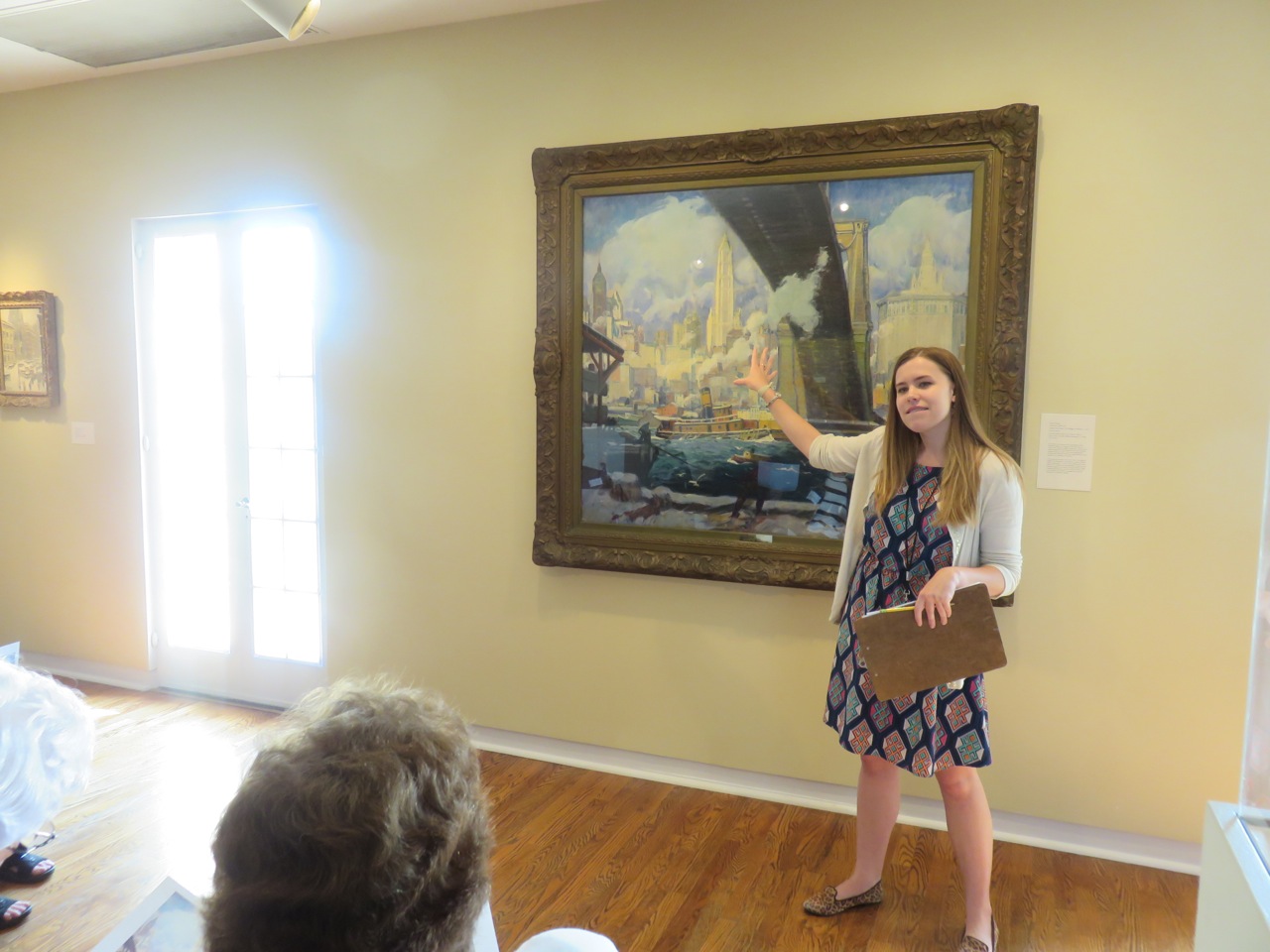
Ron and I have joined today’s session of the Focus on Art program at the Philbrook Museum of Art in Tulsa, Oklahoma. This collaboration between the Museum and the Alzheimer’s Association, Oklahoma Chapter, is part of the Association’s Drawing on Memory program and is designed for people living with dementia and their care partners.
“We’ve been hosting the program for three years and we keep learning from it,” says Jessimi Jones, Philbrook Director of Education. “We’re trying to connect people with art using their imagination and observational skills.”
“We’re also trying to engage people in conversation,” says LaShondia Horn, Early Stage Coordinator with the Association. “Looking at the art together and later creating art stimulates memories.”
Laura Voth, education assistant at the Philbrook, orchestrates the conversation and the drawing session that follows. To engage her audience, she looks for large paintings with recognizable images. Today’s oil features an old-fashioned Manhattan skyline as seen from underneath a bridge. Several boats navigate a choppy river.
Laura offers a little background on the painting, then says, “Take a look at the painting. What do you see?”
“Lots of big buildings,” Thomas says.
“What can you tell me about those buildings?” Laura asks.
“Tall,” Thomas replies.
“It looks like New York but I’ve never seen it from this angle,” Julie says.
I realize I also have never seen New York from that angle and I start noticing a few more of the picture’s details: two tugs boats, bouncing around in the rough waves, several men hoisting a rope from a dock.
“Has anyone else been to New York?” Laura asks.
“We marched through there and got right on a boat,” Thomas says. He’s got a good-natured slouch and a ready smile.
“What would it be like on that boat?” Laura asks.
“I can’t swim,” Julie says.
“I’ve been to New York as a visitor,” Mary says.
“What would you title this painting?” Laura asks.
“Under the Bridge,” Mary says.
The conversation continues as Laura asks sensory and observational questions about the picture? What time of year do you think it is? Does the painting make you feel small or tall? What do you think that round building is? What would you put in that round building?
Every one is participating, gazing at the river, the buildings, treating each question with curiosity.
After the conversations, we go downstairs to create our own art.
In the art room, each person has a large sheet of drawing paper, which is easy to see against the dark green paper that covers the table. LaShonda and her team work with the museum staff making sure each person is comfortable and can reach the art supplies. As Laura guides us through drawing simple lines to create a bridge, the conversation continues. Click here for a one-minute tutorial from Laura on using paints and oil pastels.
I’m sitting across from Emily, who says, “I can’t draw.”
I ask what color she likes and she says, “Purple.”
I show her the purple paint and ask if she’d like to try some.
She dips in her brush and strokes paint across the paper.
Color by color, she asks, “What now? What color shall I use? Where does this color go?”
During our painting session, I learn she was born in West Virginia, she doesn’t like to cook, she has five children and her brother is a wood carver. One of her treasured possessions is a carving of Dopey that her brother created when he was a teenager.
At the end, Emily has a wonderfully vibrant painting to take home and I have the wonderfully vibrant feeling of having connected with a fascinating woman.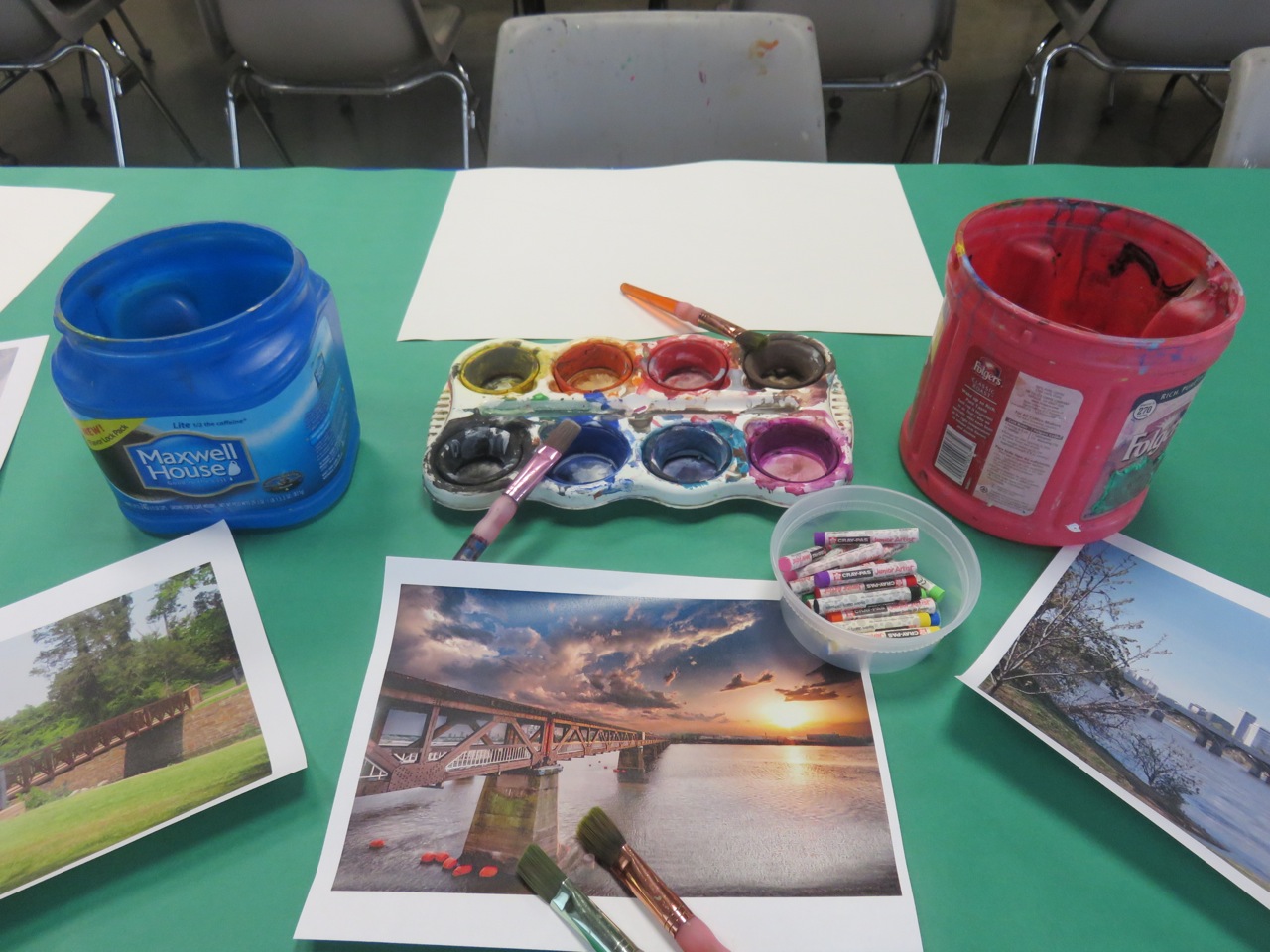
For more information about the Philbrook, go to www.philbrook.org
The Alzheimer’s Association Website is www.alz.org/
Deborah Shouse is the author of Love in the Land of Dementia: Finding Hope in the Caregiver’s Journey.
Eight Easy Actions to Evoke the Inner Artist
“Art has the power to transform, to illuminate, to educate, inspire and motivate.” Harvey Fierstein
For Mary, the brief journey from her mother’s bedroom to the Memory Unit’s community area seemed endless.
“Where are we going?” her mother, Irene, asked. “I don’t want to go. I am so confused. Where are we going? I don’t want to go.”
“We’re going to look at art, Mom,” Mary said. “It’ll be fun.”
When Mary finally got her mom settled into a chair, her mother seemed to collapse inward. Irene’s head bent; her back hunched. She cocooned into herself and seemed oblivious of the other people in the circle. Even though Irene had formerly loved going to galleries and museums, she didn’t stir when the facilitator asked, “How many of you enjoy looking at art?”
Then the facilitator came right over to Irene, gently got her attention and showed her a Norman Rockwell print that featured a young boy and a dog.
Irene stared at the picture.
“What do you see?” asked the facilitator.
“I had a dog,” Irene said. “Peaches.”
“Tell us about Peaches,” the facilitator said.
“She loved to catch balls,” Irene said. “She slept with me.”
“I had a dog named Happy,” said another woman.
“My brother had a spaniel,” said a man.
“Peaches was a terrier,” Irene said.
Mary took a deep breath and smiled as her mother talked about her dog and interacted with the others. The art had invited Irene out and Irene’s conversation had invited the others out.
“Looking at art and making observations gives people living with dementia a chance to exercise their imagination and creativity,” says Susan Shifrin, PhD, Director, ARTZ Philadelphia.The ARTZ (Artists for Alzheimer’s) program, was founded by Dr. John Zeisel and Sean Caulfield, MEd.
“When commenting on art, there are no right or wrong answers,” Susan says. “People are enlivened, realizing they still have ideas to contribute.”
Prior to a museum visit, an ARTZ facilitator brings photos of familiar works of art to a care facility, noticing which photos evoke memories, emotions and conversation. The facilitator then tailors a museum visit to feature similar art.
Even galleries without a special ARTZ program can tailor visits for those who have dementia.
Creative Sparks:
To create an ARTZ experience at home, choose art that:
- Speaks to the individual’s background or interests.
- Tells a story, such as Norman Rockwell prints about families and familiar situations.
- Features animals that the loved one likes.
Select art books from the library or use your own personal collection. For individuals deep into dementia, bright colors and abstract art are often appealing.
To create your own museum tour:
- If possible, ask a docent for a special guided tour.
- Choose one or two rooms that feature art appealing to your loved one.
- Choose at least one room that has a place to sit and look at the art.
- Move slowly and take your time looking at the art. Use the art as a catalyst for conversation.
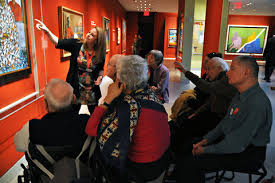 Click here for more information about ARTZ
Click here for more information about ARTZ
A portion of this article first appeared in Natural Awakenings.
Deborah Shouse is the author of Love in the Land of Dementia: Finding Hope in the Caregiver’s Journey.
“Where Words Fail, Music Speaks”
“Where words fail, music speaks”
Hans Christian Andersen
We invite you to experience an uplifting cinematic exploration of music and the mind. Alive Inside’s inspirational and emotional story left audiences humming, clapping and cheering at the 2014 Sundance Film Festival, where it won the Audience Award.
If you are not in Kansas City, Click here to look for this film in your city.
If you’re in Kansas City, please join us on Friday evening, August 15th at 7:00 at the Tivoli Theater for the premiere of Alive Inside: A Story of Music and Memory.
Here is a trailer, which has already received more than a million hits: Click here for a Preview of Alive Inside.
Alive Inside follows social worker Dan Cohen as he fights a broken healthcare system to return a deep sense of life to those living with memory loss.
Filmmaker Michael Rossato-Bennett chronicles the astonishing experiences of individuals around the country who have been revitalized through the simple experience of listening to favorite music. He reveals the uniquely human connection we find in music and how its healing power can triumph where prescription medication falls short.
The film features illuminating interviews with experts including renowned neurologist and best-selling author Oliver Sacks (Musicophilia: Tales of Music and the Brain) and musician Bobby McFerrin (“Don’t Worry, Be Happy”).
Invite Music & Memory into Your Life
“Music is an outburst of the soul.”
Frederick Delius
Dan Cohen’s Music & Memory program has a simple yet profound tenet: Figure out what music people love and let them listen to it.
This involves creating a personal playlist. Ideally, each song evokes an interesting and positive memory.
Here’s a song from my playlist:
I am pushing my cart through the neighborhood grocery store when the background music permeates my thoughts. The strains of Summer Place transport me to my growing up home in Memphis, Tenn. I see myself, age 12, sitting at my beat-up old upright piano, clunkily accompanying myself as I sing. My mother is perched on the piano bench, singing along. “There’s a summer place,” we croon. We do not have great voices but we sound good together. “Where I’ll be safe and warm.” The song offers a moment of respite during a period when Mom and I are not getting along well. Singing together makes us smile and laugh. And now, in the grocery store, in front of the heirloom tomatoes, I smile as the song envelopes me once again, connecting me with my mother, my childhood home, and that piano I earned by doing chores (including picking bag worms off our neighbor’s bushes for a penny a worm.)
What about you? What are the songs that weave through your heart and into your memory?
“Music is the language of the spirit. It opens the secret of life bringing peace, abolishing strife.” — Khalil Gibran
Deborah Shouse is the author of Love in the Land of Dementia: Finding Hope in the Caregiver’s Journey.
Transforming Attitudes Through Art
“Art enables us to find ourselves and lose ourselves at the same time.”
~ Thomas Merton
The art therapist shows up at our house, bumping along a rolling suitcase filled with supplies. Her hospice client, my life partner Ron’s 97 year-old mother Mollie, is slumped on our sofa, her head thrown back, her eyes closed. As forgetfulness nibbles away at her mind, her indifference increases.
“Hi Mollie, I’m Denise the art therapist.” Denise introduces herself again, even though they have met several times.
“Whatever,” Mollie says.
Denise unzips her suitcase and begins taking out art supplies: pink, red, yellow and green bolts of crunchy tissue paper, a plastic box of small colorful felt squares, hearts, circles, stars and triangles, two bottle of Modge Podge glue, and several paint brushes.
Denise settles beside Mollie, with a black piece of paper and some red and pink tissue.
“What color do you like best?” she asks.
Mollie shrugs but points to the pink. Denise paints a strip of glue onto her paper and sticks a crumpled bud of rose paper.
“Mollie, what shape appeals to you?” Denise asked, offering a purple felt square and a red triangle.
Mollie points to the square.
“I don’t know what to do,” Mollie says, a frequent refrain. Her encroaching confusion has knocked the center out of her normal confidence and rendered her nervous.
“Just sit here with me and help me make this picture,” Denise says.
Denise offers Mollie a choice between lilac and purple tissue, then sea green and dark green options.
“You’re an artist,” Mollie says, looking at the tissue flowers that have miraculously bloomed on the page. A garden is beginning. “You’re really an artist,” Mollie repeats and Denise smiles.
“Thank you Mollie. Can you take this brush and spread the glue?”
The brush shakes in Mollie’s hand but she manages to even out the glue, preparing the page for a tangerine and lemon colored blossom.
“This is art,” Mollie says.
“You like art, don’t you?” Denise says. “You have quite an art collection.”
Mollie nods. As she spreads the next glump of glue, Denise asks her about the antique shop she ran for many years and about her travels to get art. Mollie answers but she seems more focused on the page in front of her, the new art that Denise is bringing into her life.
Deborah is the author of Love in the Land of Dementia: Finding Hope in the Caregiver’s Journey.
Noticing Your Own Shooting Stars: The Creativity of Being a Care Partner
Several years ago, we spent an evening in Zion National Park in Utah looking for shooting stars.
“There’s one,” someone said.
“I see it!” someone else said.
I saw only the regular stars, which were also gorgeous but not quite as exciting.
“I can’t see any shooting stars,” I finally confessed.
“Here’s how you spot a shooting star,” our friend Ron told me. “You soften and widen your gaze and stare off into the middle distance. You’re looking at everything and nothing. That way you’re open to that sudden flash of light and movement.”
I didn’t see the flash of light from a shooting star that evening, but I did have an idea flash. Looking for shooting stars is like inviting out creativity. You open up your focus, relax, put yourself in receiving daydreaming mode and wait for something marvelous.
Three Tips for Noticing the Stars
For me, the art of being a care partner was an exceedingly creative endeavor. Much of the time was fraught with focus, dedicated to detail. But when I remembered to soften and widen my gaze, I was able to see my mom for the star she was, even when she seemed light years away.
Here are some tips for your own personal “star-gazing:”
Sit quietly with the person who has dementia. If appropriate, hold hands.
Let go of your history and your expectations. Appreciate her just as she is.
Open your mind and heart: be receptive to whatever flashes of light may come your way.
Tune in to the Benefits of Music: Four Noteworthy Tips
This morning, “My Girl” is playing in my head. Yesterday’s tune was “You are my Sunshine.” Music has always woven through my life, a gift from my father, who in his earlier years, worked as a DJ at various radio stations.
Music often worked its magic with my mother during her Alzheimer’s journey. This short excerpt from my story, Bringing Magic to Life, takes place in a memory care unit.
***
Rochelle sticks in another tape and soon Stardust is playing.
Mom looks up and I offer her my hand.
“Want to dance?” I ask her.
“What else,” she says, standing up.
My parents have danced to this song many times, my mother coaxing my father onto the dance floor. I hold hands with Mom and move back and forth to the music. She laughs and does the same. I twirl her, and she walks around in a jaunty little circle. For a moment, her energy and charm have returned. I feel like I have found my long-lost mother. …
***
Four Ways to Inspire Melodic Moments
Dr. Glenn Smith, a board-certified clinical neuropsychologist who specializes in Alzheimer’s disease, recently wrote about Alzheimer’s and music in the Mayo Clinic newsletter. (MayoClinic.com)
He writes:
“Limited research suggests that listening to music can benefit people who have Alzheimer’s disease in various ways.
For example, music can:
- Relieve stress
- Reduce anxiety and depression
- Reduce agitation
Music can also benefit caregivers by reducing anxiety, lightening the mood and providing a way to connect with loved ones who have Alzheimer’s disease — especially those who have difficulty communicating.”
Here are a few of his suggestions:
- Think about your loved one’s preferences. What kind of music does your loved one enjoy? What music evokes memories of happy times in his or her life? Involve family and friends by asking them to suggest songs or make playlists.
- Avoid overstimulation. When playing music, eliminate competing noises. Turn off the TV. Set the volume based on your loved one’s hearing ability. Opt for music that isn’t interrupted by commercials, which can cause confusion.
- Encourage movement. Help your loved one to clap along or tap his or her feet to the beat. If possible, dance with your loved one.
- Pay attention to your loved one’s response. If your loved one seems to enjoy particular songs, play them often. If your loved one reacts negatively to a particular song or type of music, choose something else.
To learn more about Dr. Glenn, visit http://www.mayoclinic.org/expert-biographies/glenn-smith-ph-d/BIO-20025110
For more about the benefits of music, read Dr. Glenn’s entire article.
http://www.mayoclinic.com/health/music-and-alzheimers/AN02184
To see our HERO Project that features music, visit
http://thecreativityconnection.com/html/tuning_in.html
Let Go and Notice the Answers
For me, part of being a care partner is letting go of worry and control and being open to intuition and flow. Here is a story from my life where I almost didn’t notice I was “in the flow!” Has this ever happened to you?
Opening to Answers
“Some people think it’s holding that makes one strong — sometimes it’s letting go.” -Unknown
Driving to the writer’s conference, my hands were sweating and my throat was tight. I had given workshops before, but I felt very nervous about this one. What if I had nothing to say? What if nobody learned anything? What if they looked at me with bored and indifferent eyes?
As I drove down 55th street, I thought, “You have prepared and you are going to do your best. Now it’s time to ‘let go and let God.’” I took a deep breath and felt a little better.
Then my inner worrywart boomed, “You could have tried harder, practiced more, done more research. You don’t have one original thing to say.” By the time, I pulled into the parking lot the steering wheel was damp with my sweat.
The conference was held in a mid-town church and the lobby was bustling with people.
“Your room is down the stairs and to your right,” the woman in charge told me.
I walked down the stairs and to the right. I saw a bathroom and a coat closet. I opened one door into a maintenance room, stacked with toilet paper and paper towels, brooms and mops. Then I noticed another room: tucked into an obscure corner — it was a small chapel. I walked in, taking in the serenity, the rich maroon color of the chairs, the soothing pattern of the stained glass windows. I felt calm and centered in this room. I tiptoed to the pulpit and stood behind it, like I had something holy to say.
Then I realized, I was going to be late for my class, Frantically, I retraced my steps, but I couldn’t find any room large enough for a class. I raced upstairs and found the woman again.
“I can’t find my room,” I told her. “There’s only a chapel in that area.”
“That is your room,” she said, “You’re teaching in the chapel.”
I walked back down slowly, smiling all the way.
My prayer, to let go and let God, had been answered in a most concrete way. I had almost been too busy worrying to notice.
An Alzheimer’s Holiday Blessing
As my mother’s Alzheimer’s progressed, her spiritual openness increased.
This is an excerpt from my book Love in the Land of Dementia that describes Mom’s new way of celebrating the holidays.
**
We roll back into the facility’s dining room just as the show is ready to start. The singer, Thelda, kicks off her shoes and presses play on the boom box. Above the cheerful sound track, she sings Jingle Bells. She dances across the room with the remnants of ballroom steps. She stops in front of Mom and sings right to her. She gets on her knees, so she can look into Mom’s eyes, and keeps singing. Mom notices her and smiles a little.
Thelda moves on, singing to each of the patients gathered around, so intent on making a connection that she often forgets the words.
“Is it all right for your Mom to come to Christmas holiday events?” the activity director had asked me, when Mom moved into the skilled care portion of the nursing home.
“Yes, I’d like her to go to any activities. She likes the extra energy.”
I think Mom would approve of my decision, even though she has never celebrated Christmas. Growing up, her immigrant mother held on to the Jewish spirit of her home, kneading dough for Friday evening challah, observing each holiday and prayer period in her own way. Some orthodox women followed the religious law that commanded a small piece of the dough be burned as an offering to God. My grandmother was poor; she did not believe in burning good food, regardless of tradition. So she sacrificed a portion of the dough to her youngest daughter, my mother Fran. She created a “bread tail,” leftover dough that she baked, then smeared with butter and sprinkled with sugar . When Mom used to talk about her mother, she always mentioned this special treat.
Even when I was growing up, and we were the only Jewish family in our neighborhood, my mother still did not sing Christmas song. She let the holiday rush by her, like a large train, whooshing past and leaving her behind.
Now, I am singing Christmas carols to my Mom for the first time and she is smiling. She has moved beyond the place where the religions are different, beyond the place where she wants to separate the dough and make a sacrifice for tradition. Her new tradition is anyone who can make her smile.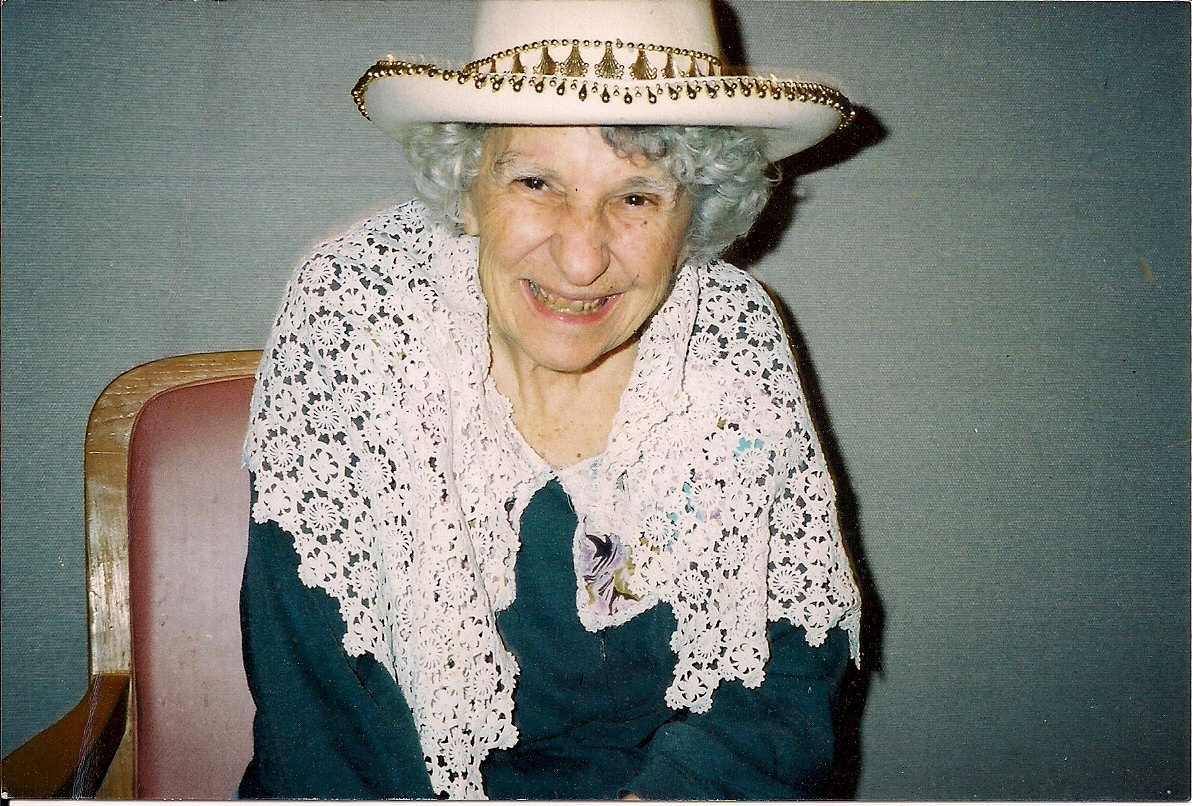
With each song, from White Christmas, to Silver Bells, to Frosty the Snowman, Thelda moves back to Mom, tapping her, acting sillier and sillier. Each time, Mom lifts her head and widens her mouth for a second.
For her finale, Thelda puts on a big red nose and sings Rudolph. When she dances in front of Mom with that scarlet nose, Mom laughs, her face a miracle in pure enjoyment. I laugh too, so delighted to see Mom engaged and absorbed.
Two weeks from now, I will bring a menorah and candles into my mother’s room. My father and I will have a short Chanukah ceremony with Mom. She will pick at the shiny paper covering the Chanukah gelt (chocolate candy disguised as money). She will slump over in her chair. But she will come back to life when she sees me, her only daughter, wearing a big red nose as I light the menorah.Here’s to a meaningful and fun holiday season.
I look forward to connecting with you when I resume blogging in early January.
Drawing out the Inner Artist: Seven Tips for Engaging People who have Dementia
“Every child is an artist. The problem is how to remain an artist once he grows up.” ― Pablo Picasso
Sharing the arts is one of our passions. We so appreciate the insightful work of Michael Samuels, M.D., co-founder and director, Arts as a Healing Force. These are his words, which originally appeared in the Huffington Post:
Anyone can use the healing power of art to reach a loved one living with Alzheimer’s disease. All it takes is an ordinary person who loves and cares for another. A recent article in the Boston Globe says, “Making music, painting or dancing — and seeing or hearing it — may be the most effective treatment for dementia to date.”
There has been new exciting research about art and Alzheimer’s that sheds light on this remarkable way of healing. Music and art stimulate areas of the brain not affected by Alzheimer’s and accesses memories through routes that avoid affected language centers. Art actually helps the brain navigate new neurological communication pathways. Even if the Alzheimer’s patient is unresponsive and can’t remember where they are, a song can stimulate the sweet memories of youth that lay long buried.
Any art that the Alzheimer’s patient enjoys will open a huge new way of healing — for yourself and for the one you love.
TIPS:
You can do it. Professional training is not necessary; anyone can be an artist/healer for a person living with Alzheimer’s.
Keep it simple. Music is the easiest and most researched way to reach a person with Alzheimer’s but you also can use painting, sculpting and poetry. Gear your art to the person’s skill level at the moment.
Go into the past to heal the present. Art evokes memories. Any art that brings up a memory is powerful. A song from a past event evokes the memory of a first kiss. A painting or photograph of the family home can help evoke childhood memories.
Make it stimulating. Choose bright colors, collage from old photograph albums, lively music, dances.
Make art in a sacred space. Make the place as wonderful and beautiful as you can. Play soft music in the background — make the lighting bright enough to see easily, add scents from aroma therapy and even make a small altar with loved objects from the past.
Support with loving kindness and compassion. Make all your comments nonjudgmental and loving. Art and healing is about process, not the product. It’s all about love and relationship.
Ask them to tell you the story about the artwork. If your loved one can still speak ask them to share the memories that come with the art, music or words.
According to the Alzheimer’s Association, music and art can enrich the lives of people with Alzheimer’s disease by allowing for self-expression and engagement even after dementia has progressed. Many organizations are using the power of art to help those living with Alzheimer’s. The Assisted Living Federation of America (ALFA) has an annual art contest at senior centers to encourage elderly people to stimulate their brains by making art. The I’m Still Here Foundation started Artists for Alzheimer’s initiative (ARTZ) that helps more than 10,000 Alzheimer’s and dementia patients attend arts events. This greatly enhances the lives of Alzheimer’s patients and reduces their symptoms.
Michael Samuels, M.D., Co-founder and director, Arts as a Healing Force
MICHAEL SAMUELS M.D. is a physician, artist, guided imagery specialist, and one of the foremost experts in body, mind, and spirit medicine today. He is the co-founder and director of Arts as a Healing Force. Samuels teaches at San Francisco State University’s Institute of Holistic Studies and is the author of 22 books, including the bestsellers The Well Body Book, Seeing with the Mind’s Eye, and the Well Baby Book. His latest book is HEALING WITH THE ARTS: A 12-Week Program to Heal Yourself and Your Community, co-authored by Mary Rockwood Lane, R.N., Ph.D.